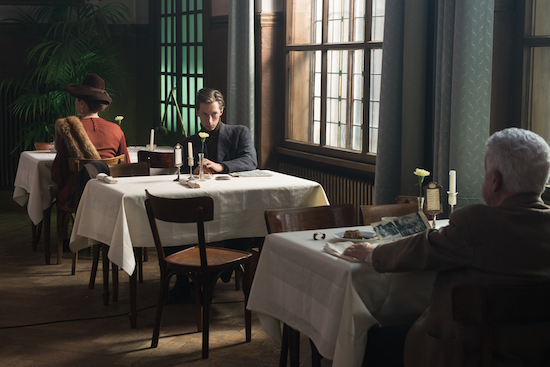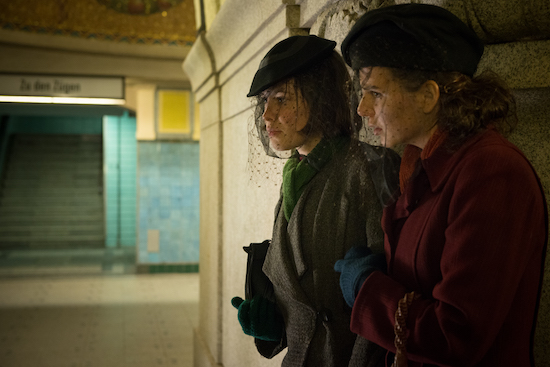The Invisibles: Hiding in Plain Sight

There have been many worthwhile films about the World World II Holocaust and its survivors. Though it seems as though every angle has been covered, The Invisibles, a riveting docudrama by German filmmaker Claus Ráfle, is an unusually compelling new addition to the genre.
Goebbels declared Berlin free of Jews in 1943 (the city originally numbered 160,000); however, out of the 7000 who resisted deportation and remained, 1500 were left by the war’s end. The Invisibles follows four young Berliners, as they individually defy the Nazi mandate to evacuate via deportation, choosing instead to wait out the war as veritable fugitives in their own city.
Cioma Schönhaus, Hanni Lévy, Ruth Arndt and Eugen Friede are skillfully portrayed by actors in their youth and appear as themselves discussing their experiences decades later. Ráfle smoothly weaves their individual stories together, creating a movie that plays like a spy thriller as the protagonists face mounting danger from Nazis and, ironically, Allied bombs and invasion, while finding help from various heroic resistors.
Though their plights are obviously similar, the four had different experiences marked by a shared characteristic: a sort of youthful fearlessness and resourcefulness, combined with a fierce will to survive.

In 1942 Schönhaus (Max Mauff), a somewhat cocky, 20-year-old art student, is separated from his parents at the deportation center when he declares that he works in a gun factory doing important work for the state, granting him exempt status. The same year, 20-year-old Arnt (Ruby O. Fee) and her close-knit family are helped by friends who agree to hide them “until the war is over,” thought to be imminent.
By early 1943, Jews were not allowed radios, bikes or pets. They needed permits to ride public transportation.
The youngest at 16, Friede (Aaron Altares) is hidden by his non-Jewish stepfather. We see him chastised on a bus for not wearing a star, then ordered to give up his seat by the conductor. Another passenger gives Eugen a pack of cigarettes, an example of the sympathy felt by some fellow Berliners.
An orphan, 17-year-old Hanni Levy (Alice Dwyer), went into hiding after the family raising her were deported. She dyes her hair blonde, later recalling, “I became someone else.” During the day, she goes out into the bustling Kurfürstendamm and tries to blend in, being careful to “act normal” though she compulsively scans her surroundings.

Courtesy of Greenwich Entertainment
Interspersed with the reenactments and interview snippets is black and white footage of 1940s Berlin, a dynamic city not unlike New York, where it was plausible to believe that one could disappear into the crowd.
The enterprising Cioma, skilled at forging passports, finds work with a resistance leader. Posing as a soldier called into service, he is able to procure a list of temporary lodgings. Eugen stays with sympathetic Communist friends of his father but is forced to move elsewhere when they fall under suspicion. For a while, his life is almost normal, unlike Ruth, who later talks about the constant exhaustion and hunger.
As the war progresses and the Nazis crack down, the four manage to cope with their terrible circumstances. Ruth and a friend pose as war widows in veils, finding escape at the cinema; Hanni also finds refuge at the movies, later befriending and moving in with a woman who works at the theater.
A striking aspect of the film is the number of non-Jewish resistors willing to endanger themselves and their families to help the four, including at one point, an SS officer who hires Ruth and her friend as maids.
There are appearances by the infamous informer Stella Goldschlag and notoriously intrepid resistor Werner Scharff, larger than life characters (for wildly different reasons) who add considerable color and tension to the film.
The arrival of U.S. bombers is cheered by the protagonists, though Berlin is decimated by the attacks. Similarly, they welcome the arrival of Russian troops, though the latter generally refuse to believe that anyone left in the city is Jewish. A scene featuring an emotional encounter with one disbelieving Russian soldier is one of the movie’s highlights.
That the four managed to stay alive and carry out their lives in various countries, including the U.S., seems miraculous. The Invisibles is a well-crafted tribute to the 1500 who survived and to those who helped make it possible.
The Invisibles opens on Friday, January 25, at Landmark 57 West and Quad Cinema.
—Marina Zogbi

